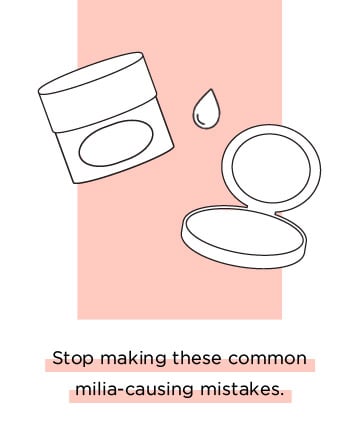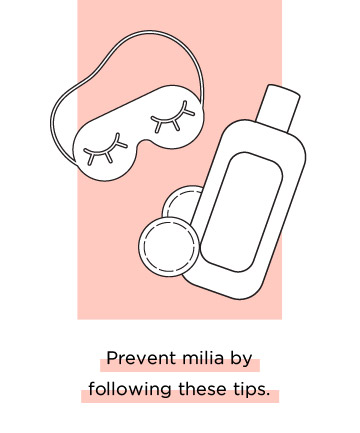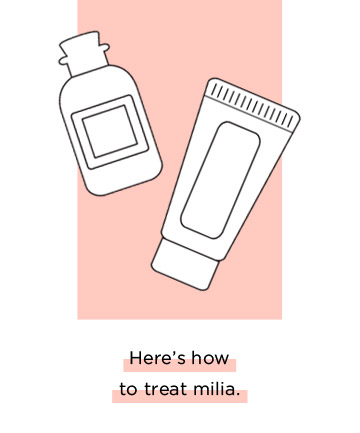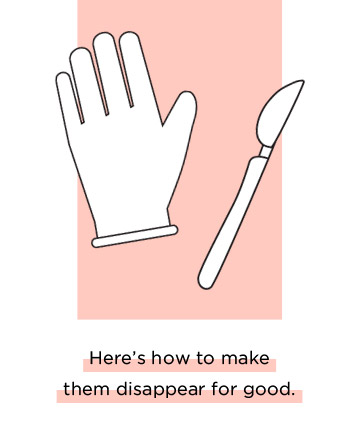You may have noticed a tiny, raised white bump (or few) around your eyes or on your face and had no idea what it was. If it's not a pimple or a whitehead, it could be a milia (otherwise known as an inclusion cyst).
"A milia is a small amount of grease that is plugged in the pore but in its own capsule — like a pearl," explains South Florida-based dermatologist Dr. Gary Goldfaden, founder of Goldfaden MD Skin Care. These bumps most often show up on your cheeks and forehead, but can also appear on any part of your body, even your genitals (yikes!).
And, according to Goldfaden, 75 to 85 percent of women will get at least one milia in her lifetime. NYC based dermatologist Dr. Marina Peredo, at Skinfluence NYC, says these cysts are about one to two millimeters in size, and can also be caused by flakes of skin trapped in small pockets of the skin.
Image via Imaxtree
"A milia is a small amount of grease that is plugged in the pore but in its own capsule — like a pearl," explains South Florida-based dermatologist Dr. Gary Goldfaden, founder of Goldfaden MD Skin Care. These bumps most often show up on your cheeks and forehead, but can also appear on any part of your body, even your genitals (yikes!).
And, according to Goldfaden, 75 to 85 percent of women will get at least one milia in her lifetime. NYC based dermatologist Dr. Marina Peredo, at Skinfluence NYC, says these cysts are about one to two millimeters in size, and can also be caused by flakes of skin trapped in small pockets of the skin.
Image via Imaxtree
Here's the freaky truth about milia: Dr. Elizabeth Tanzi, founder and director of Capital Laser & Skin Care and Clinical Professor of Dermatology at the George Washington Medical Center, says that many times there is simply no reason for them. (Cue the flashlight, campfire and scary stories.)
However, there are exceptions. Goldfaden says that using skin care and makeup that's too heavy or greasy for your skin, which can clog your pores, can bring them on. Instead of turning into acne, the clogged pore transforms into a milia (I know, and you thought the occasional pimple from sleeping in your makeup was bad).
"In the case of a milia, the pore becomes full with excess oil, make up, etc. then the skin actually grows over the pore, trapping it in," explains Vanessa Hernandez, consulting celebrity esthetician for L'Oréal Paris (she successfully got rid of one of my colleague's milia) -- this is what makes milia different from blackheads and acne, and also why they're so hard to get rid of.
Peredo adds that a strong corticosteroid or contact dermatitis can also contribute to the formation of milia.
However, there are exceptions. Goldfaden says that using skin care and makeup that's too heavy or greasy for your skin, which can clog your pores, can bring them on. Instead of turning into acne, the clogged pore transforms into a milia (I know, and you thought the occasional pimple from sleeping in your makeup was bad).
"In the case of a milia, the pore becomes full with excess oil, make up, etc. then the skin actually grows over the pore, trapping it in," explains Vanessa Hernandez, consulting celebrity esthetician for L'Oréal Paris (she successfully got rid of one of my colleague's milia) -- this is what makes milia different from blackheads and acne, and also why they're so hard to get rid of.
Peredo adds that a strong corticosteroid or contact dermatitis can also contribute to the formation of milia.
Some nights, the desire to sink into your covers without removing your makeup is too overwhelming to fight. I get it. The struggle is real (especially if puppy snuggles are involved). But going to sleep with your makeup on not only causes acne and premature aging, it also causes...milia (dun dun dun), says Hernandez.
Since they can occur all over your face, don't think you can just wipe off your BB cream and leave your eye makeup intact. Remove all traces of makeup; Goldfaden says that certain makeup (even your beloved mascara) can contribute to milia if it's too oily, especially if you sleep in it. Moral of the story: just take off your damn makeup before you go to bed.
"The best way to prevent milia is to keep your skin exfoliated on a daily basis, along with not using products that are overly rich for your skin type," says Hernandez.
Peredo adds that using a glycolic or enzyme-based cleanser that dissolves surface impurities can help prevent them from forming. If you notice that you're prone to milia, chemical peels, DermaSweep micro-resurfacing or Clear and Brilliant laser treatments can also be helpful, Peredo says.
Since they can occur all over your face, don't think you can just wipe off your BB cream and leave your eye makeup intact. Remove all traces of makeup; Goldfaden says that certain makeup (even your beloved mascara) can contribute to milia if it's too oily, especially if you sleep in it. Moral of the story: just take off your damn makeup before you go to bed.
"The best way to prevent milia is to keep your skin exfoliated on a daily basis, along with not using products that are overly rich for your skin type," says Hernandez.
Peredo adds that using a glycolic or enzyme-based cleanser that dissolves surface impurities can help prevent them from forming. If you notice that you're prone to milia, chemical peels, DermaSweep micro-resurfacing or Clear and Brilliant laser treatments can also be helpful, Peredo says.
Now that you're probably scrutinizing your face in the mirror looking for signs of milia, it's time to warn you: If you find any, "above all, do not try to extract them at home," says Peredo. Treating milia takes a certain finesse that your fingernails just can't provide.
"Milia are much deeper than blackheads and require a puncture to the skin to remove, not just pressure with an aestheticians tool," adds Tanzi. So, put away your blackhead extractor. In case there was any doubt in your mind that picking milia is probably worse than picking at a pimple, Goldfaden adds that doing so can lead to infection and scarring (and, you won't even get the satisfaction popping a pimple may bring, as, again, it takes a puncture to the skin to actually remove milia).
Peredo recommends over-the-counter home peels, which will dissolve the top layer of your skin safely and without irritation. Hernandez adds, "Unfortunately, once you have milia the only thing you can do that may help is scrub your skin with a gentle exfoliator on a daily basis to minimize the milia from growing larger." She recommends L'Oréal Paris Go 360 Clean Deep Exfoliating Scrub, $4.99.
"Milia are much deeper than blackheads and require a puncture to the skin to remove, not just pressure with an aestheticians tool," adds Tanzi. So, put away your blackhead extractor. In case there was any doubt in your mind that picking milia is probably worse than picking at a pimple, Goldfaden adds that doing so can lead to infection and scarring (and, you won't even get the satisfaction popping a pimple may bring, as, again, it takes a puncture to the skin to actually remove milia).
Peredo recommends over-the-counter home peels, which will dissolve the top layer of your skin safely and without irritation. Hernandez adds, "Unfortunately, once you have milia the only thing you can do that may help is scrub your skin with a gentle exfoliator on a daily basis to minimize the milia from growing larger." She recommends L'Oréal Paris Go 360 Clean Deep Exfoliating Scrub, $4.99.
Make an appointment with your dermatologist, stat. "A milia needs to be lanced, then gently extracted — either consult with your dermatologist or your aesthetician," says Hernandez. "They will then create a small opening with a lancet, and apply gentle pressure and that allows the milia to pop right out." However, she cautions that you must go to someone who is experienced in extracting milia, as they can be more difficult to take out than they look.
Tanzi adds that it's an easy procedure for a dermatologist, so your best bet may be going to your derm's office first.
"But, milia will never stop forming until the skin care practices that are causing them change," warns Goldfaden. Tanzi echoes his statement, saying that if you find you're getting a lot of milia suddenly, take a long hard look at your skin care routine and make some changes. That eye cream may feel magical, creamy and wonderful on your skin, but if it's giving you milia, it may be time to retire it. After all, you wouldn't keep using a face cream that caused you to break out or gave you a rash, would you?
Tanzi adds that it's an easy procedure for a dermatologist, so your best bet may be going to your derm's office first.
"But, milia will never stop forming until the skin care practices that are causing them change," warns Goldfaden. Tanzi echoes his statement, saying that if you find you're getting a lot of milia suddenly, take a long hard look at your skin care routine and make some changes. That eye cream may feel magical, creamy and wonderful on your skin, but if it's giving you milia, it may be time to retire it. After all, you wouldn't keep using a face cream that caused you to break out or gave you a rash, would you?
You've probably had at least one milia in your lifetime. And, you probably didn't even know what they were -- just some random small white bumps on your skin. Most commonly, milia show up under your eyes and on your face, and you can't remove milia on your own. We talked to top dermatologists and aestheticians to find out how to get rid of milia -- and how to prevent them from popping up in the first place.






